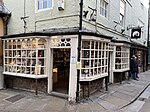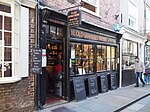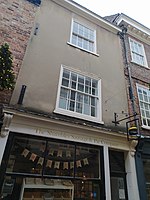3–5 The Shambles
19th-century establishments in England19th century in YorkGrade II listed buildings in YorkGrade II listed housesHouses in North Yorkshire ... and 3 more
The ShamblesUse British English from January 2023Yorkshire building and structure stubs
3–5 The Shambles is an historic trio of buildings in the English city of York, North Yorkshire. Grade II listed, parts of the structures date to the early 19th century.Its orange-grey bricks are in Flemish bond, while the shopfront and guttering is made of timber.One of the buildings formerly served as the Shoulder of Mutton public house. Numbers 1 to 5 were modernised in 1970–71, the result of which created a series of individual businesses, with a single suite above for office space.As of 2018, the buildings were occupied by Take One Gifts and The Shambles Sweet Shop.
Excerpt from the Wikipedia article 3–5 The Shambles (License: CC BY-SA 3.0, Authors).3–5 The Shambles
Shambles, York Bishophill
Geographical coordinates (GPS) Address Nearby Places Show on map
Geographical coordinates (GPS)
| Latitude | Longitude |
|---|---|
| N 53.95978579 ° | E -1.080275657 ° |
Address
Barghest
Shambles 1
YO1 7LZ York, Bishophill
England, United Kingdom
Open on Google Maps








